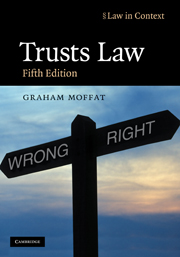Book contents
- Frontmatter
- Contents
- Preface to the fifth edition
- Acknowledgments
- Table of abbreviations
- Useful websites
- Table of statutes
- Table of statutory instruments
- Table of cases
- 1 Trusts introduced
- 2 The evolution of the private express trust
- 3 Taxation, wealth-holding and the private trust
- 4 Creating the trust – I
- 5 Creating the trust – II
- 6 Trusts and public policy
- 7 Flexibility in relation to beneficial entitlement
- 8 The taxation of private trusts
- 9 An introduction to trustees and trusteeship
- 10 Aspects of the management of trusts
- 11 Trusteeship, control and breach of trust
- 12 Implied trusts and the family home
- 13 Trusts in commerce I: occupational pension schemes
- 14 Trusts in commerce II: commerce and equitable remedies
- 15 Trusts in commerce III: commerce, credit and the trust
- 16 Trusts in commerce IV: fiduciary relationships, commerce and the trust
- 17 Trust, contract and unincorporated associations
- 18 An introduction to the law of charity
- 19 A legal definition of ‘charity’
- 20 The regulation of charities
- Index
20 - The regulation of charities
- Frontmatter
- Contents
- Preface to the fifth edition
- Acknowledgments
- Table of abbreviations
- Useful websites
- Table of statutes
- Table of statutory instruments
- Table of cases
- 1 Trusts introduced
- 2 The evolution of the private express trust
- 3 Taxation, wealth-holding and the private trust
- 4 Creating the trust – I
- 5 Creating the trust – II
- 6 Trusts and public policy
- 7 Flexibility in relation to beneficial entitlement
- 8 The taxation of private trusts
- 9 An introduction to trustees and trusteeship
- 10 Aspects of the management of trusts
- 11 Trusteeship, control and breach of trust
- 12 Implied trusts and the family home
- 13 Trusts in commerce I: occupational pension schemes
- 14 Trusts in commerce II: commerce and equitable remedies
- 15 Trusts in commerce III: commerce, credit and the trust
- 16 Trusts in commerce IV: fiduciary relationships, commerce and the trust
- 17 Trust, contract and unincorporated associations
- 18 An introduction to the law of charity
- 19 A legal definition of ‘charity’
- 20 The regulation of charities
- Index
Summary
Introduction
In Chapter 18 we noted that the Charitable Trusts Acts 1853–1860 established, for the first time, a central permanent Charity Commission empowered to supervise the management of charitable trusts and to remodel their purposes when they proved impracticable or impossible. But its role was severely constrained in three particular respects: (1) its jurisdiction, which extended to certain charitable endowments only and not to ‘collecting’ charities; (2) its freedom to act of its own motion, which was limited by the degree of autonomy preserved for trustees; and (3) the circumstances in which the Charity Commissioners (or the court) could make cy-près schemes.
Since then two trends in the legal and administrative framework regulating charity have become apparent. On the one hand, charities have been favoured more, notably in financial respects. On the other hand, an attempt has been made to extract a higher price from charities in return for these favours by extending and strengthening the supervisory framework, initially via the Charities Act 1960. This statute enacted most of the recommendations for reform contained in the Nathan Report (Committee on the Law and Practice Relating to Charitable Trusts (Cmd 8710, 1952)). Notwithstanding these changes, concern about the efficiency of charities and the effectiveness of supervision over them grew apace, culminating in a series of critical reports in the late 1980s (see An Efficiency Scrutiny of the Supervision of Charities (Woodfield Report) (1987); National Audit Office (NAO) Monitoring and Control of Charities in England and Wales (HC Paper no 380 (1986–87) and HC Paper no 13 (1990–91)); Public Accounts Committee (HC Paper no 116 (1987–88) and HC Paper no 85 (1991)).
- Type
- Chapter
- Information
- Trusts LawText and Materials, pp. 1036 - 1080Publisher: Cambridge University PressPrint publication year: 2009



